转:解释lsh
Locality sensitive hashing — LSH explained
The problem of finding duplicate documents in a list may look like a simple task — use a hash table, and the job is done quickly and the algorithm is fast. However, if we need to find not only exact duplicates, but also documents with differences such as typos or different words, the problem becomes much more complex. In my case, I’ve had to find duplicates in a very long list of given questions.
Jaccard index
First, we need to define a method of determining whether a question is a duplicate of another. After experimenting with string distance metrics (Levenshtein, Jaro-Winkler, Jaccard index) I’ve come to the conclusion that the Jaccard index performs sufficiently for this use case. The Jaccard index is an intersection over a union. We count the amount of common elements from two sets, and divide by the number of elements that belong to either the first set, the second set, or both. Let’s have a look at the example:
Assuming that we have two following questions:
“Who was the first ruler of Poland”
“Who was the first king of Poland”
We can visualize it in the following sets:
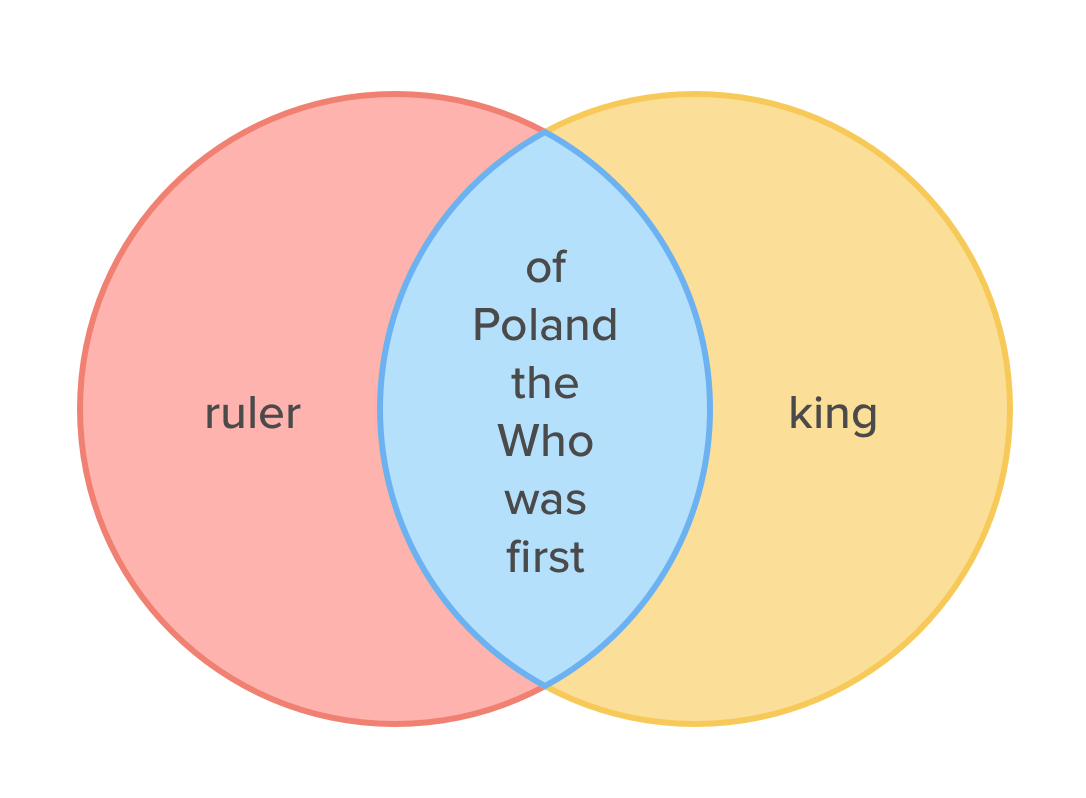
The size of the intersection is 6, while the size of the union is 6 + 1 + 1 = 8, thus the Jaccard index is equal to 6 / 8 = 0.75
We can conclude — the more common words, the bigger the Jaccard index, the more probable it is that two questions are a duplicate. So where we can set a threshold above which pairs would be marked as a duplicate? For now, let’s assume 0.5 as a threshold, but in a real life, we need to get this value by experiment. We could stop here, but current solution makes a number of comparisons growing quadratically (It’s 0.5*(n²-n) where n is the number of questions).
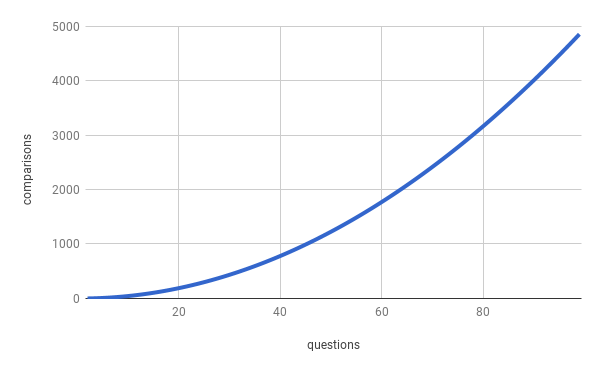
Min part of MinHash
It’s been shown earlier that the Jaccard can be a good string metric, however, we need to split each question into the words, then, compare the two sets, and repeat for every pair. The amount of pairs will grow rapidly. What if we somehow created a simple fixed-size numeric fingerprint for each sentence and then just compare the fingerprints?
In this section I will use following questions:
“Who was the first king of Poland”
“Who was the first ruler of Poland”
“Who was the last pharaoh of Egypt”
And their Jaccard indexes:
J(“Who was the first king of Poland”, “Who was the first ruler of Poland”) = 0.75
J(“Who was the first king of Poland”,“Who was the last pharaoh of Egypt”) = 0.4
J(“Who was the first ruler of Poland”, “Who was the last pharaoh of Egypt”)=0.4
To calculate MinHash we need to create the dictionary (a set of all words) from all our questions. Then, create a random permutation:
(“last”, “Who”, “Egypt”, “king”, “ruler”, “was”, “of”, “Poland”, “pharaoh”, “the”, “first”)
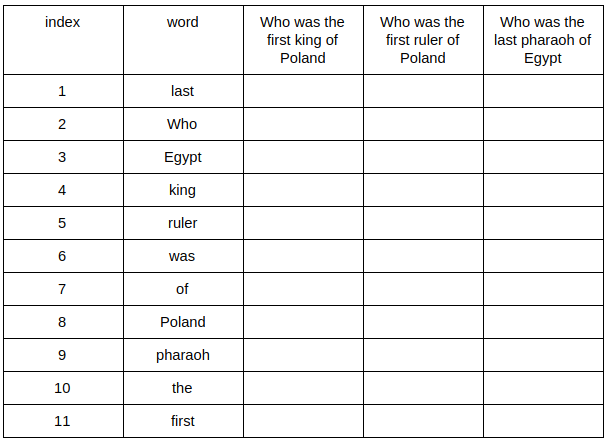
We have to iterate over the rows, writing the index in the respective cell, if the word being checked is present in the sentence.

Now the second row:

And the rest:
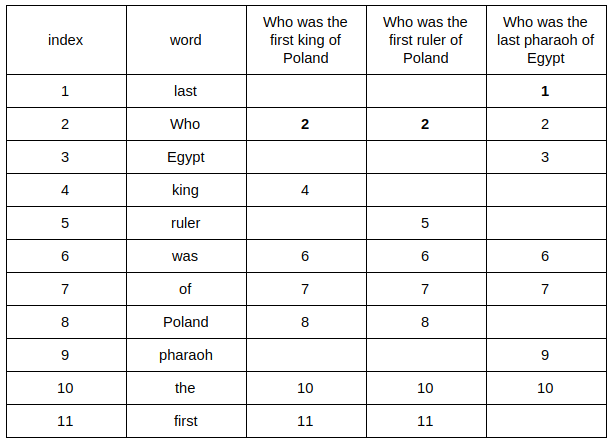
Only the first word occurrence is relevant (giving a minimal index — hence the name MinHash). We have a minimum value for all our questions and the first part of the fingerprint. To get the second one we need to create another random permutation and retrace our steps: /////只有出现的第一个单词是相关的(给出最小索引,因此命名为MinHash)。我们对所有的问题和指纹的第一部分都有一个最小值。为了得到第二个,我们需要创建另一个随机排列,并返回我们的步骤
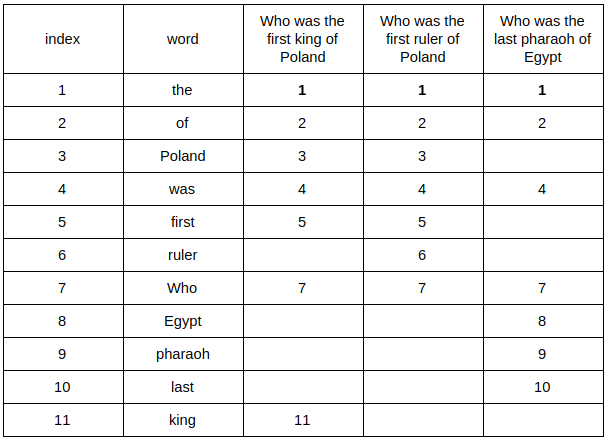
Then, we repeat permuting and searching as many times as big we want our fingerprint. For the purpose of example my consists of 6 items. We’ve already had 2, so let’s create 4 more permutations:
(“first”, “king”, “Egypt”, “was”, “Who”, “of”, “pharaoh”, “last”, “Poland”, “ruler”, “the”)
(“ruler”, “king”, “Poland”, “Who”, “the”, “pharaoh”, “of”, “first”, “Egypt”, “last”, “was”)
(“king”, “Poland”, “ruler”, “last”, “pharaoh”, “the”, “Who”, “Egypt”, “first”, “of”, “was”)
(“the”, “pharaoh”, “Who”, “ruler”, “Poland”, “Egypt”, “king”, “last”, “was”, “first”, “of”)
Our complete MinHashes are:
MinHash(“Who was the first king of Poland”) = [2, 1, 1, 2, 1, 1]
MinHash(“Who was the first ruler of Poland”) = [2, 1, 1, 1, 1, 1]
MinHash(“Who was the last pharaoh of Egypt”) = [1, 1, 3, 4, 4, 1]
Now we can check how similar are two MinHashes by calculating their Jaccard indexes:
MinHashSimilarity(“Who was the first king of Poland”, “Who was the first ruler of Poland”) = 5/6 ≈ 0.83
MinHashSimilarity(“Who was the first king of Poland”, “Who was the last pharaoh of Egypt”) = 2/6 ≈ 0.33
MinHashSimilarity(“Who was the first ruler of Poland”, “Who was the last pharaoh of Egypt”) = 2/6 ≈ 0.33
Well, that’s really close to their Jaccard indexes, and the more permutations we do, the closer the approximations get. How’s that possible?
Let’s analyze how we calculate the Jaccard index. We need to look at our table. Considering only two questions, we can create a table like the following:
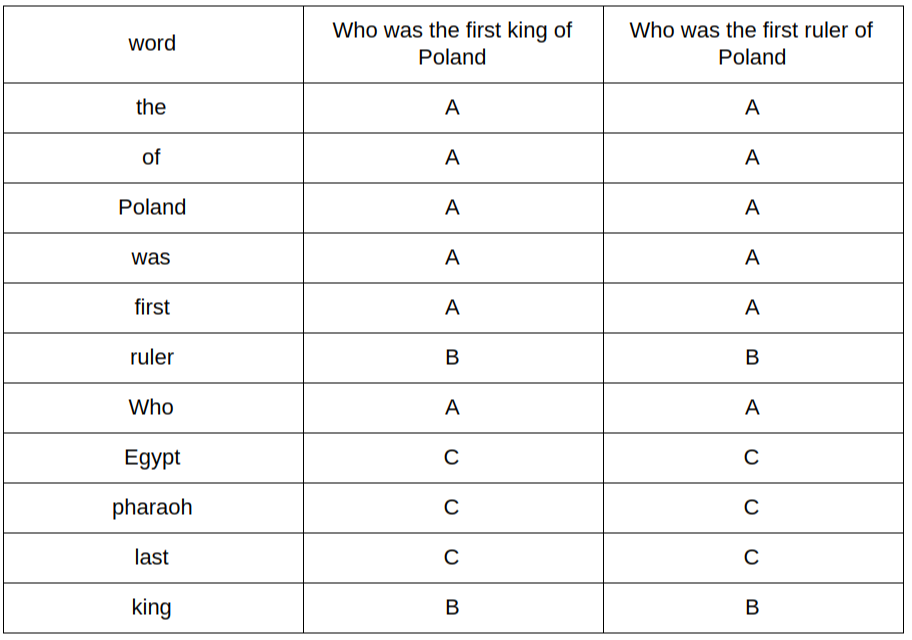
A — where the word is present in both questions
B —it’s present in one of them
C — it’s in the dictionary, but in neither of the questions
We can write the formula for the Jaccard index as a/(a+b) where a is a number of rows of type A and b of type B
Now since we have random permutations, let’s count a probability that two questions will have an equal fingerprint component. We can skip type C rows since they do not interfere in any way with a component value calculation (If we consider only two questions). So what is the probability that we will take type A row, from the set of A and B rows? P = a/(a + b) which is exactly the same as Jaccard index! That explains why our approximations were close and why more permutations mean better approximations.
Hash part of MinHash
We now have an algorithm which could potentially perform better, but the more documents the bigger the dictionary, and thus the higher the cost of creating permutations, both in time and hardware. Instead of creating n permutations we can take a hash function (like md5, sha256 etc.) use it on every word in the question and find a minimal hash value. It will be the first element of the fingerprint, then we will take another hash function, and so on until we have our n elements in the fingerprint. Wait, but why does it work?
Let’s wonder what permutation does — it basically maps each word from dictionary to a different number. The fact that mapped numbers are integers increased by one is not important to us.
What are hash functions doing? Simplifying — they map string to a number, so basically the same as the permutation! How is that better? We don’t need the whole dictionary before — if the new question appears we can easily calculate its MinHash. Also, we don’t need to scan the whole dictionary for each question and create a permutation of the whole dictionary. Both of these operations are pretty costly. We just saved a lot of our and our’s computer time.
So now we can compute a fingerprint and compare it easily, but still we need to compare every fingerprint with all others. This is bad. Exponentially bad.
LSH
Let’s look back at our MinHashes:
MinHash(“Who was the first king of Poland”) = [2, 1, 1, 2, 1, 1]
MinHash(“Who was the first ruler of Poland”) = [2, 1, 1, 1, 1, 1]
MinHash(“Who was the last pharaoh of Egypt”) = [1, 1, 3, 4, 4, 1]
Now group them by three elements:
MinHash(“Who was the first king of Poland”) =[2, 1, 1, 2, 1, 1] => [211, 211]
MinHash(“Who was the first ruler of Poland”) =[2, 1, 1, 1, 1, 1] => [211, 111]
MinHash(“Who was the last pharaoh of Egypt”)=[1, 1, 3, 4, 4, 1]=>[113,441]
What can we see? Our duplicates have one common group (first) where unique has no common groups. Since still, we’re talking about probability influenced issue let’s calculate what is the probability of at least one common group for duplicates:
- Probability of one specific element common in fingerprint = Jaccard index = P1 = 0.75
- Probability that all elements in one group are identical = Jaccard index to number of elements in group power = P2 = 0.75³ = 0.421875
- Probability that group will be different = P3 = 1-P2 = 0.578125
- Probability that all groups will be different = P4 to number of groups power = P3² = 0.334228516
- And finally — Probability that at least one group will be common = P5 = 1 — P4 = 0.665771484
So general equation will look like this: P5 = 1 — (1 — Jn)b
Where:
J — Jaccard index
n — number of elements in group
b — number of groups
And probability for our unique question is 1 — (1–0.4³)² = 0.123904 — much lower. We could also make 3 groups 2 elements each. Here is plot:
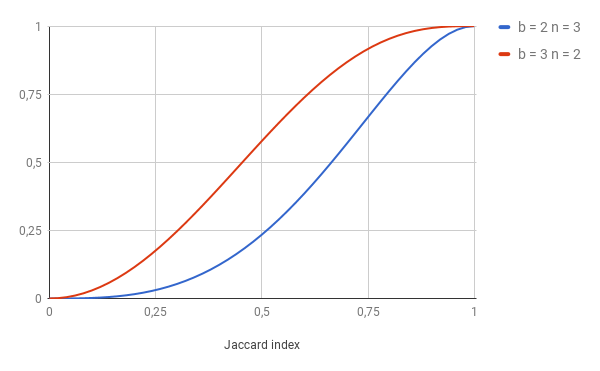
Let’s analyze it: For the pair with J = 0.5 and b = 3, there is only 0.25 probability that we would find it as a duplicate. However, with b = 3 there is about 0.6 probability that we would mark it as a duplicate. What does it mean in practice? — More false positives for b = 3 and more false negatives for b = 2. We need to choose carefully our parameters, but more on that later.
Now we do not need to count anything — if there is a common group we can mark it as duplicates. We can just create lists with single groups:
[211, 211]
[211, 111]
[113, 441]
↓
[
211 => “Who was the first king of Poland”,
211 => “Who was the first ruler of Poland”,
113 => “Who was the last pharaoh of Egypt”
]
And
[
211 => “Who was the first king of Poland”,
111 => “Who was the first ruler of Poland”,
441 => “Who was the last pharaoh of Egypt”
]
It looks familiar to Hashtable! We can put columns of groups in the hash table and check for collision. Collision means that we hit a duplicate. And operations on the hash table have worst case scenario complexity of O(n), so our algorithm (of course depends on implementation) have potential to be also O(n) complex. Way better than O(n²) we had at the beginning.
Tweaking
After what we’ve learned so far we know that LSH takes, 3 arguments:
k — number of elements in MinHash
n — number of elements in groups (or buckets)
b — number of buckets and b*n must equal k
Our goal is to mark as duplicate every pair, or more, that have Jaccard index >= 0.17, so our probability chart should look like this:
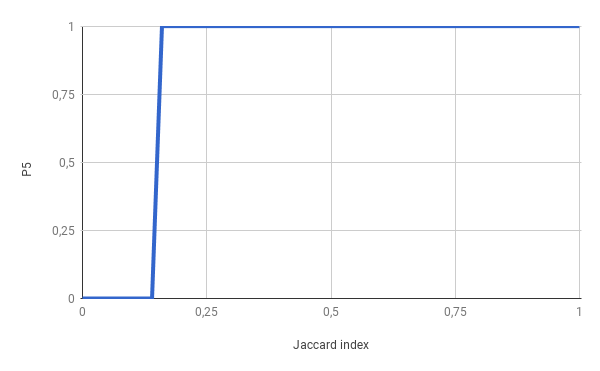
Achieving step function is impossible in our case, so by manipulating our 3 parameters we need to approximate this as close as possible having in mind that bigger the k, more computing power we need (more hashes to calculate). After experiments, I’ve found that 200 for k is good starting value and it also has many divisors. Although 240 has more, so it would be my next shot.
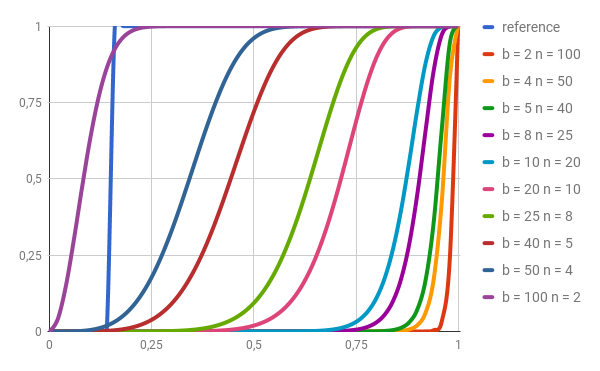
As we can see b = 100 n = 2 or b = 50 n = 4 are the ones closest to reference. We should use both and then compare results.
One thing left — where to get 200 hash functions? Two example solutions:
- use MurmurHash with 200 different seeds
- create our own hash function by taking the output of md5 or another hash function and making XOR with some random number. Example python code:
def myFirstHash(string):
return md5(hash) ^ 636192
def mySecondHash(string):
return md5(hash) ^ 8217622
# And so on.
# But do it in a loop!
Warning — LSH can, and sometimes will produce accidental collisions, so at the end, we still need to compare all questions in given collision but it will be much much fewer operations than comparing all to each other.
And that would be all for now. In next article, I will show example implementation and some benchmarks.
转自:
https://medium.com/engineering-brainly/locality-sensitive-hashing-explained-304eb39291e4
转:解释lsh的更多相关文章
- 实习日记:图像检索算法 LSH 的总结与分析(matlab)
最开始仿真和精度测试,基于 matlab 完成的. Demo_MakeTable.m (生成 Hash 表) %======================================== %** ...
- 海量数据挖掘MMDS week7: 局部敏感哈希LSH(进阶)
http://blog.csdn.net/pipisorry/article/details/49686913 海量数据挖掘Mining Massive Datasets(MMDs) -Jure Le ...
- 海量数据挖掘MMDS week2: 局部敏感哈希Locality-Sensitive Hashing, LSH
http://blog.csdn.net/pipisorry/article/details/48858661 海量数据挖掘Mining Massive Datasets(MMDs) -Jure Le ...
- Locality Sensitive Hashing,LSH
1. 基本思想 局部敏感(Locality Senstitive):即空间中距离较近的点映射后发生冲突的概率高,空间中距离较远的点映射后发生冲突的概率低. 局部敏感哈希的基本思想类似于一种空间域转换思 ...
- Halcon算子解释
Halcon算子解释大全 Halcon/Visionpro视频教程和资料,请访问 重码网,网址: http://www.211code.com Chapter 1 :Classification 1. ...
- BOW模型在ANN框架下的解释
原文链接:http://blog.csdn.net/jwh_bupt/article/details/17540561 作者的视野好,赞一个. 哥德尔第一完备性定理,始终是没有能看完完整的证明,艹!看 ...
- 图像检索中为什么仍用BOW和LSH
原文链接:http://blog.csdn.net/jwh_bupt/article/details/27713453 去年年底的时候在一篇博客中,用ANN的框架解释了BOW模型[1],并与LSH[2 ...
- 位姿检索PoseRecognition:LSH算法.p稳定哈希
位姿检索使用了LSH方法,而不使用PNP方法,是有一定的来由的.主要的工作会转移到特征提取和检索的算法上面来,有得必有失.因此,放弃了解析的方法之后,又放弃了优化的方法,最后陷入了检索的汪洋大海. 0 ...
- 从Go语言编码角度解释实现简易区块链
区块链技术 人们可以用许多不同的方式解释区块链技术,其中通过加密货币来看区块链一直是主流.大多数人接触区块链技术都是从比特币谈起,但比特币仅仅是众多加密货币的一种. 到底什么是区块链技术? 从金融学相 ...
随机推荐
- IP 层收发报文简要剖析4--ip 报文发送
无论是从本地输出的数据还是转发的数据报文,经过路由后都要输出到网络设备,而输出到网络设备的接口就是dst_output(output)函数 路由的时候,dst_output函数设置为ip_output ...
- Markdown 常用语言关键字
Markdown 语法高亮支持的语言还是比较多的,记下来备用. 语言名 关键字 Bash bash CoffeeScript coffeescript C++ cpp C# cs CSS css Di ...
- Mysql_笔记2018.1.29
1.主要数据库 Oracle MySQL Sqlsever 微软 MongoDB (非关系型数据库) 2.MySql 专业词语 1.数据库:一些关联表的集合 2.数据表:表示数据的矩阵 3.列:同ex ...
- Natapp内网穿透服务工具
在做微信开发的时候,调用微信接口成功之后,微信会回调我们事先配置好的一个接口.由于微信的服务是在外网的,所以这个回调接口也只能是外网,而且微信要求回调接口只能是通过ICP备案的域名,不能使用IP,所以 ...
- php在线预览pdf文件
话不多说,直接上代码 <?php public function read_pdf($file) { if(strtolower(substr(strrchr($file,'.'),1)) != ...
- Guitar Pro编辑歌词教程
吉他是常见的乐器之一,弹唱亦是音乐爱好者们最常见的表演方式.Guitar Pro(win系统)是吉他爱好者最常用的吉他谱制作软件,大家可以在该软件上创作自己的吉他谱.既然有了谱子,那自然是少不了歌词了 ...
- pycharm2020激活破解和汉化
一:破解补丁和程序下载:链接:https://pan.baidu.com/s/1u-aZrKMmfRBlQHtcivUt8Q 提取码:tvko 二:破解步骤: 1.安装下载的pycharm202 ...
- Meetings S 题解
题目描述 题目链接 有两个牛棚位于一维数轴上的点 \(0\) 和 \(L\) 处.同时有 \(N\) 头奶牛位于数轴上不同的位置(将牛棚和奶牛看作点).每头奶牛 \(i\) 初始时位于某个位置 \(x ...
- C语言讲义——全局变量和局部变量
局部变量 普通的局部变量也叫动态变量,默认有个关键字叫auto,可以省略.有两种形式: 1.函数内的局部变量 2.复合语句内的局部变量:for(int i = 0; i<5; i++){-} 静 ...
- Java基础教程——包装类
Java出道之时,自诩为"纯面向对象的语言",意思是之前的所谓"面向对象语言"不纯. 但是,有人指责Java也不纯--8种基本类型并非类类型.为此,Java为他 ...
